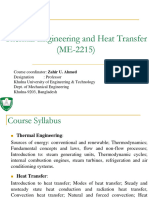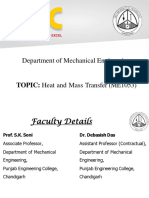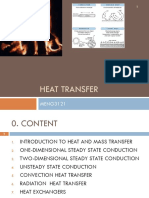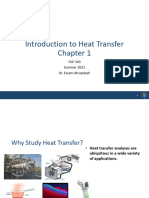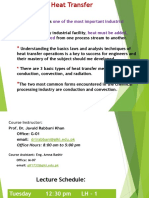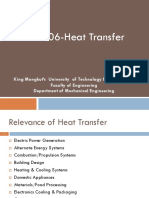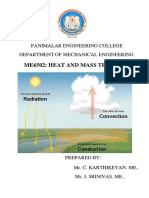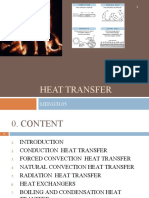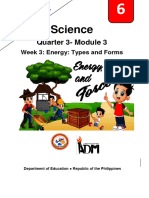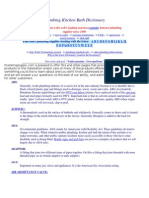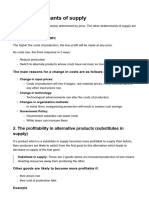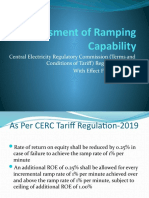MECH3310
Heat Transfer
Shuhuai Yao
Department of Mechanical and Aerospace Engineering
The Hong Kong University of Science and Technology
S. Yao MECH3310 Lecture 1 Ch 1.1-1.2 01/09/2016
�Course Information
Instructor:
YAO, Shuhuai (RM2577F, Tel 2358-7205, meshyao@ust.hk)
Lectures:
Tue/Thu 10:30-11:50, Rm 4334, Lift 3
Office Hours: Mon 16:00-17:00 or by appointment
LIYANTO, Henry hliyanto@connect.ust.hk
SHANG, Yuhe yshangaa@connect.ust.hk
TRAIPATTANAKUL, Bhawat btaa@connect.ust.hk
Tutorials:
Fri 18:00-18:50, Rm 4334, Lift 3
Office hours: Thu 16:00-18:00, CYT 4007
TAs:
Textbook:
References:
Principles of Heat and Mass Transfer, Ebook, Incropera et al.
Heat and Mass Transfer: A Practical Approach, engel.
Course Web: https://canvas.ust.hk/courses/5112
Homework:
Exams:
Grading:
8 highest scores (out of 9) will be counted
Mid-term (in class, March 30) & Final (TBA)
Homework (15%) Midterm (35%) Final (45%) Class Quiz (5%)
S. Yao MECH3310 Lecture 1 Ch 1.1-1.2 01/09/2016
�OBE Matrix
COURSE OBJECTIVES:
(correlated COURSE
OUTCOMES are shown in
the bracket)
COURSE OUTCOMES:
(correlated COURSE
OBJECTIVES are shown
in the bracket)
ASSESSMENT TOOLS:
(correlated COURSE
OBJECTIVES are shown
in the bracket)
1. To provide our students with a fundamental understanding of
heat transfer processes. [1,5]
2. To provide our students with the ability to apply knowledge of
mathematics and science to solve engineering problems in heat
transfer. [2,3,4]
3. To provide our students with the ability to identify a suitable
model and formulate scientific analysis for practical problems in
heat transfer. [2,3,4]
4. To inspire students to understand the nature (wind chill) and
man-made (heat sink) system involving heat transfer using the
knowledge obtained in classes. [5]
1. Explain the basic concepts of conduction, convection and
radiation heat transfer. [1]
2. Formulate and solve simple conduction heat transfer problems,
using techniques including both closed form and numerical
methods. [2,3]
3. Apply empirical correlations for both forced and natural
convection to determine values for the convection heat transfer
coefficient. [2,3]
4. Examine blackbody and gray surface radiation, and evaluate
radiation exchange between surfaces. [2,3]
5. Apply the principles of conduction, convection and radiation heat
transfer to analyze natural phenomena. [4]
1.
2.
3.
4.
Regular homework assignments [2,3]
Class participation and discussion [4]
Optional class quizzes [1]
Mid-term and final examinations [1,2]
S. Yao MECH3310 Lecture 1 Ch 1.1-1.2 01/09/2016
�Week
Day
1/9
CONCEPTS
6/9
CONCEPTS
8/9
CONDUCTION FUNDAMENTALS
13/9
1-D STEADY CONDUCTION
15/9
1-D STEADY CONDUCTION
20/9
22/9
1-D STEADY CONDUCTION
1-D STEADY CONDUCTION
HW#2
27/9
TRANSIENT CONDUCTION
HW#3
29/9
TRANSIENT CONDUCTION
4/10
2-D CONDUCTION
6/10
CONVECTION FUNDAMENTALS
11/10
CONVECTION FUNDAMENTALS
13/10
EXTERNAL CONVECTION
18/10
Midterm Review
20/10
Midterm
25/10
INTERNAL CONVECTION
27/10
INTERNAL CONVECTION
10
1/11
3/11
INTERNAL CONVECTION NATURAL
CONVECTION
11
8/11
PHASE CHANGE
10/11
RADIATION FUNDAMENTALS
15/11
RADIATION FUNDAMENTALS
17/11
RADIATIVE TRANSFER
13
22/11
24/11
RADIATIVE TRANSFER RADIATIVE
TRANSFER
HW#8
14
29/11
Final Review
HW#9
6
7
8
9
12
Topic
S. Yao MECH3310 Lecture 1 Ch 1.1-1.2 01/09/2016
Due
HW#1
HW#4
HW#5
HW#6
HW#7
�Key Questions
What is Heat Transfer?
Rate of energy flow in the form of heat due to a temperature difference
What is the relationship to Thermodynamics?
The laws of thermodynamics:
0th Law: Thermal equilibrium underline the definition of temperature
1st Law: Conservation of energy
2nd Law: Entropy increasing
Heat transfer:
to quantify the rate of heat being transferred in a nonequilibrium process
thermal forms of energy flow in conservation of energy obey the 1st law
always occurs from a hot body to a cold one obey the 2nd law
Why is Heat Transfer important?
Human body, household appliances, electronics, automobiles, global warming
S. Yao MECH3310 Lecture 1 Ch 1.1-1.2 01/09/2016
�Heat Transfer takes place everywhere
S. Yao MECH3310 Lecture 1 Ch 1.1-1.2 01/09/2016
�Modes of Heat Transfer
https://www.youtube.com/watch?v=O3N9XyTkSBI
S. Yao MECH3310 Lecture 1 Ch 1.1-1.2 01/09/2016
�Modes of Heat Transfer
Conduction: Heat transfer in a solid or a stationary fluid (gas or liquid) due to
the random motion of its constituent atoms, molecules and /or
electrons.
Convection: Heat transfer due to the combined influence of bulk and
random motion for fluid flow over a surface.
Radiation:
Energy that is emitted by matter due to changes in the electron
configurations of its atoms or molecules and is transported as
electromagnetic waves (or photons).
Conduction and convection require temperature variations in a material medium.
Although radiation originates from matter, its transport does not require a material
medium and occurs most efficiently in a vacuum.
S. Yao MECH3310 Lecture 1 Ch 1.1-1.2 01/09/2016
�Heat Transfer Rates: Conduction
Conduction:
Due to random motion, not bulk motion
Transfer of energy from the more energetic particles of a substance to
the adjacent less energetic ones as a result of interactions between the
particles.
Conduction can take place in solids, liquids, or gases
In gases and liquids conduction is due to the collisions and diffusion of
the molecules during their random motion.
In solids conduction is due to the combination of vibrations of the
molecules in a lattice and the energy transport by free electrons.
S. Yao MECH3310 Lecture 1 Ch 1.1-1.2 01/09/2016
�Heat Transfer Rates: Conduction
Fouriers law of heat conduction:
q = kT
Heat flux
2
[W/m2]
Thermal conductivity Temperature gradient
[W/(mK)]
[K/m]
Apply to 1D with constant k:
qx = k
dT
T T
T T
= k 2 1 = k 1 2
dx
L
L
Reflection of 2nd Law
q x = qx A
Heat rate
[W]
q=
qx A
x
S. Yao MECH3310 Lecture 1 Ch 1.1-1.2 01/09/2016
10
�Heat Transfer Rates: Convection
Convection = Conduction + Advection (bulk motion)
Relation of convection to flow over a
surface and development of velocity
and thermal boundary layers:
Convection is commonly classified
into three sub-modes:
- Forced convection,
- Natural (or free)
convection,
- Change of phase
(liquid/vapor, solid/liquid,
etc.)
S. Yao MECH3310 Lecture 1 Ch 1.1-1.2 01/09/2016
11
�Heat Transfer Rates: Convection
Newtons law of cooling:
q = h(Ts T )
Convection heat transfer coefficient
[W/(m2K)]
Sir Isaac Newton
(1643-1727)
h depends on variables such as the surface geometry, the nature of
fluid motion, the properties of the fluid, and the bulk fluid velocity.
h = f (x*, k, , v)
q=
qx A
x
S. Yao MECH3310 Lecture 1 Ch 1.1-1.2 01/09/2016
12
�Heat Transfer Rates: Radiation
Radiation is the energy emitted by matter in the form of
electromagnetic waves (or photons) as a result of the changes in the
electronic configurations of the atoms or molecules.
Heat transfer by radiation does not require the presence of an
intervening medium.
In heat transfer studies we are interested in thermal radiation (radiation
emitted by bodies because of their temperature).
Radiation is a volumetric phenomenon. However, radiation is usually
considered to be a surface phenomenon for solids that are opaque to
thermal radiation.
Emission: Stefan-Boltzmann Law
E b = Ts4
Ts: [K]
Stefan-Boltzmann constant
= 5.67e-8 [W/(m2K4)]
S. Yao MECH3310 Lecture 1 Ch 1.1-1.2 01/09/2016
13
�Heat Transfer Rates: Radiation
The idealized surface that emits radiation at the maximum rate is
called a blackbody. E b = Ts4
The radiation emitted by all real surfaces is less than the radiation emitted
by a blackbody at the same temperature, and is expressed as
E = Ts4
Emission power Emissivity of the surface, 0 1
[W/m2]
Irradiation: Special case of surface exposed to large surroundings of
4
uniform temperature, G = Tsur
Gabs = G
Absorption Absorptivity Irradiation
[W/m2]
[W/m2]
01
For = , net rate of radiation heat flux:
4
qrad" = Eb G = (Ts4 Tsur
)
S. Yao MECH3310 Lecture 1 Ch 1.1-1.2 01/09/2016
14
�S. Yao MECH3310 Lecture 1 Ch 1.1-1.2 01/09/2016
15
�Example 1.1 Heat conduction through a wall. Find qx and qx .
S. Yao MECH3310 Lecture 1 Ch 1.1-1.2 01/09/2016
16
�Example 1.2 Heat loss through convection and radiation per unit length.
S. Yao MECH3310 Lecture 1 Ch 1.1-1.2 01/09/2016
17


